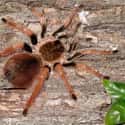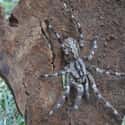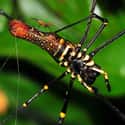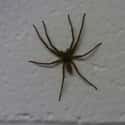-
(#8) Colombian Giant Redleg Tarantula
Three words: "cartwheel of death." That's what some people have taken to calling the unique defensive behavior of the Colombian Giant Redleg tarantula. While most tarantulas wave their front legs and bare their fangs when threatened, the Colombian Redleg does something very different. It spins in a circle. This isn't just showing off, though. It adds thrust to the barbs that line this particular tarantula's back legs. These irritating barbs can scrape predators or get hurled into the air to clog mucous membranes, causing pain or temporary blindness.
It's also sometimes called the Eye-Candy tarantula due to its unique markings.
Average Size: With a leg span ranging from 6 to 8 inches, that's a lot of back leg to throw those barbs from!
Comparative Size: Even at the small end, they're still almost twice the size of a softball.
Region: This striking and unique tarantula hails from Colombia.
Is It Dangerous To Humans? Like most tarantulas, the Redleg is venomous, but not enough so to do much harm to humans unless they happen to be allergic. What you've got to be more concerned about is that aforementioned "cartwheel of death." It certainly won't cause your demise, but it can cause a lot of pain and discomfort if those barbs get in your nose or eyes.
-
(#5) Face-Sized Tarantula
If that name doesn't make you uncomfortable, you're probably not an arachnophobe. Its scientific name is Poecilotheria rajaei, but the recently discovered Face-Sized tarantula got its common name because, well, it's as big as your face! This Sri Lankan tarantula has also started making its way into buildings more and more often, as its preferred habitat (old-growth trees) is lost to deforestation. With enough venom to take the lives of small rodents, birds, lizards, and even snakes, the Face-Sized tarantula is also quite fast.
Fortunately for arachnophobes (and unfortunately for the Poecilotheria rajaei), it is fairly rare, even in its native country, and the elimination of its natural habitat has likely rendered this enormous spider rarer still.
Average Size: The Poecilotheria rajaei has a leg span of about 8 inches. However, its body is relatively small compared to its legs, at least as tarantulas go.
Comparative Size: It's right there in the name. The Face-Sized tarantula is as big as an average person's face.
Region: Discovered in 2009, the Poecilotheria rajaei has, thankfully, thus far only been found in Sri Lanka, so unless you're exploring abandoned buildings there, you probably don't have to worry about running into one.
Is It Dangerous To Humans? The bite of a Face-Sized tarantula is deadly to snakes, lizards, birds, and small mammals, but it isn't going to do much to a person. That's probably not a lot of comfort if you wake up in the middle of the night with one proving the truth of its name, though.
-
(#2) Giant Huntsman Spider
Considered the largest spider in the world by leg span, the Giant Huntsman spider is also no cuddly tarantula. Instead, this member of the Huntsman spider family (many of which are native to Australia, of course) is a quick, aggressive hunter - hurray! Fortunately for the rest of the world, the Giant Huntsman, which was first discovered in 2001, has thus far only been found in the southeast Asian country of Laos, where it dwells near the entrances of caves.
While its legs get really long, the Giant Huntsman is also much smaller than the Goliath Birdeater in body size, reaching a length of only about 2 inches. That's probably not a lot of comfort to the poor arachnophobe who spots a spider bigger than a dinner plate, though.
Average Size: The leg span of a Giant Huntsman can reach upwards of 12 inches in diameter.
Comparative Size: A Giant Huntsman's leg span is bigger than the average dinner plate and only slightly smaller than the average steering wheel.
Region: Luckily for the majority of us, these rare spiders have thus far only been spotted in Laos.
Is It Dangerous To Humans? The Huntsman gets its name from the fact that it doesn't build webs but instead chases down and strikes its prey. That's not great news. Fortunately for humans, the bite of a Giant Huntsman isn't likely to cause anything worse than pain and swelling accompanied by mild nausea and headaches.
-
(#9) Chaco Golden Knee Tarantula
With a maximum leg span of around 7 inches, the Chaco Golden Knee tarantula, a grassland tarantula hailing from Argentina and Paraguay, isn't as large as some of the other members of the tarantula family, but it's still bigger than most other spiders in the world. Its name comes from the distinctive yellowish markings around the joints on its eight legs.
Like several other large tarantulas, Golden Knee tarantulas are popular as pets. They are docile, and their urticating hairs - which they shed from their abdomen as a defensive mechanism - are milder than that of many other tarantulas. They are also aggressive eaters, which makes them more fun to watch than some other, shier tarantula varieties.
Average Size: Chaco Golden Knee tarantulas are smaller than some tarantula types, but still get pretty large, with leg spans that can reach 7 or, in some cases, even 8 inches.
Comparative Size: At around a 7-inch leg span, a Golden Knee tarantula would be the size of a 45-rpm record.
Region: Argentina and Paraguay.
Is It Dangerous To Humans? No one has ever perished from a tarantula bite and, even among tarantulas, the Chaco Golden Knee is known to be especially docile and mild. That doesn't mean that it won't bite if provoked, or that a bite won't hurt.
-
(#11) Golden Orb-Weaver Spider
The rare Nephila komaci, a member of the Golden Orb-Weaver family, is the largest web-spinning spider that has thus far been discovered - or, at least, the female is. Displaying an unusual amount of sexual dimorphism, the female Nephila komaci reaches a leg span of up to 5 inches, while the tiny male is less than an inch. Once the spiders have mated, the male typically spends the rest of his life clambering around on his partner's back, fending off other males.
Nephila komaci, which spins webs up to 3 feet across, was first identified in a museum specimen in 2000. At the time, it was feared that this newly discovered species was already extinct. However, in 2007 a field team located three of these rare spiders in South Africa.
Average Size: For females, up to 5 inches. For males, only about an inch.
Comparative Size: As the largest web-spinning spider thus far discovered, the leg span of an adult female Nephila komaci can be about the size of a grapefruit.
Region: Thus far, these huge web-spinners have only been found in South Africa's Tembe Elephant Park.
Is It Dangerous To Humans? The biggest danger is walking into one of their huge webs - but even that isn't too much of a concern for most people, given that only three specimens of this spider have been found in the wild so far.
-
(#12) Hawaiian Cane Spider
The Hawaiian Cane spider achieved viral internet fame thanks to a doctored photo (that was actually of a wolf spider) claiming to show a Giant Hawaiian Cane spider (or, in other variations, an Angolan Witch spider or a Colombian Diablo spider) with a leg span of nearly 6 feet clutched onto the side of a Florida house. The giant arachnid in the picture may have been a bit of digital trickery, but the Hawaiian Cane spider is real enough.
While actual Cane spiders are nowhere near 6 feet, they're still pretty big, as spiders go. With a body about an inch long and a leg span that can reach 5 inches, these spiders don't spin webs but instead hunt for their food. As their name implies, they're fond of cane fields, and they sometimes make their way into homes, but they're quite harmless to humans, and actually good for catching bugs and other pests. They're also good mothers. In fact, the mother Cane spider carries her egg case around in her mouth for up to a month, during which time she doesn't eat in order to guard her young.
Average Size: While 5 inches may not appear like a lot after seeing a doctored photo of a spider 6 feet across, the Hawaiian Cane spider does still get pretty big.
Comparative Size: With a 5-inch leg span, the Cane spider is about the size of a can of tuna.
Region: Cane spiders can be found on every one of the Hawaiian islands where, as their name suggests, they like to hang out in cane fields.
Is It Dangerous To Humans? Nope! Cane spiders rarely bite, and when they do, they seldom inject venom. Even if you are exposed to Cane spider venom, it's unlikely to cause you any problems unless you're allergic. In fact, Cane spiders are quite beneficial to have around because they prey on pest insects.
New Random Displays Display All By Ranking
About This Tool
It is impossible to have a spider as big as a slap in our cognition, but there are indeed giant spiders in the spider world. There are about 40,000 different spider species living on the earth. They crawl on the web with their 8 furry legs and ready to pounce and kill prey anytime they want. There is no doubt that spiders are small but they can bring a nightmare. Usually, we see spiders that are only a few centimeters long, and some spiders that can be raised can reach the size of a palm.
The largest spider we know so far is Theraphosa Blondi, officially recognized by the Guinness Book of World Records, its legs can be up to 30 cm long, which is equivalent to the length of a child's forearm. The random tool lists 12 other biggest spiders on the planet.
Our data comes from Ranker, If you want to participate in the ranking of items displayed on this page, please click here.















